Do not trust the fake "Abnormal Network Traffic On This Device" pop-up
Phishing/ScamAlso Known As: "Abnormal Network Traffic On This Device" pop-up
Get free scan and check if your device is infected.
Remove it nowTo use full-featured product, you have to purchase a license for Combo Cleaner. Seven days free trial available. Combo Cleaner is owned and operated by RCS LT, the parent company of PCRisk.com.
What kind of scam is "Abnormal Network Traffic On This Device"?
While inspecting suspicious websites, our research team discovered a malicious setup promoting the "Abnormal Network Traffic On This Device" scam. It is noteworthy that the installer also endorsed the CovidDash browser hijacker, as well as a bunch of other questionable applications.
After we executed the malicious file, it displayed a pop-up window. The message therein was disguised as an alert from Microsoft. The fake warning stated that due to suspicious network traffic, the user's device had been blocked from the network. The goal of this scam pop-up is to trick victims into visiting a phishing website.
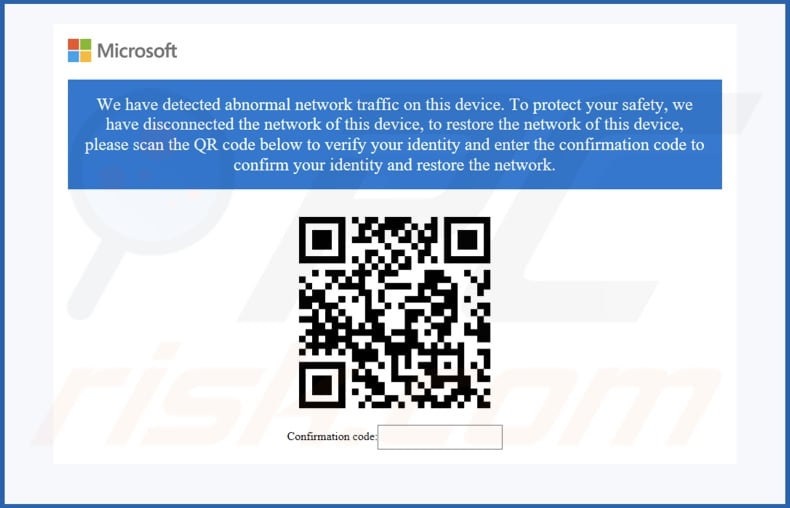
"Abnormal Network Traffic On This Device" scam overview
When we executed a malicious setup on our testing system, it opened a scam pop-up window. The text in it was presented as a warning from Microsoft. The pop-up stated that suspicious network traffic was detected on the device. For safety reasons, the computer was supposedly disconnected from the network.
What's interesting is that the installer which delivers this pop-up actually disconnects the computer from the Internet. This is rather unusual as most of claims stated by scam messages are false. It is very likely the cyber criminals do this to prevent users prevent users from accessing the web and downloading anti-virus software that would remove it. You can find more information on how to restore the Internet connection below.
The message then instructed to scan the QR code provided below for identity verification and network restoration purposes. After the QR was scanned, it resulted in a redirect to a rogue website. The initially opened page reiterated the message from the pop-up and instructed to click "Continue".
Disabling Internet connection on the infected machine shouldn't cause major traffic losses for cyber criminals, since most of users scan QR codes using mobile devices.
Once the button was pressed, another page was opened. Likewise retaining the Microsoft disguise, the phishing site was presented as a form requiring users to provide their personally identifiable and credit card information. To elaborate, the webpage contained input fields for the cardholder's name, credit card number, expiration date, CVV, addresses, and phone number.
By entering the requested information into the phishing website – users will inadvertently disclose it to scammers. This data could then be used to steal victims' identities, as well as make fraudulent transactions and online purchases. If you have already provided your private data to this scam – immediately contact the appropriate authorities.
It is pertinent to mention that the fake pop-up could be used to promote a different malicious site.
It must be emphasized that all the claims made by the "Abnormal Network Traffic On This Device" scam are fake, and they are in no way associated with the actual Microsoft Corporation.
In summary, by trusting a scam like "Abnormal Network Traffic On This Device" – users can experience system infections, severe privacy issues, financial losses, and identity theft.
| Name | "Abnormal Network Traffic On This Device" pop-up |
| Threat Type | Phishing, Scam, Social Engineering, Fraud |
| Fake Claim | Abnormal activity was detected on user's device network – hence, it was disconnected. |
| Disguise | Microsoft |
| Detection Names (malicious setup) | Combo Cleaner (Trojan.Hulk.Gen.5), Emsisoft (Trojan.Hulk.Gen.5 (B)), F-Secure (Trojan:W32/GenInflated.B), Kaspersky (HEUR:Trojan.Win32.Agent.gen), Rising (Trojan.Antier!1.9D9B (CLASSIC)), Full List Of Detections (VirusTotal) |
| Rogue process name | Windows host process (Rundll32) [process name may vary] |
| Related Domains | 0zpt4.za[.]com, pcrrent[.]com |
| Detection Names (0zpt4.za[.]com) | N/A (VirusTotal) |
| Serving IP Address (0zpt4.za[.]com) | 172.67.159.146 |
| Symptoms | Fake error messages, fake system warnings, pop-up errors. |
| Distribution methods | Malicious setups, compromised websites, rogue online pop-up ads, potentially unwanted applications. |
| Damage | Loss of sensitive private information, monetary loss, identity theft, possible malware infections. |
| Malware Removal (Windows) |
To eliminate possible malware infections, scan your computer with legitimate antivirus software. Our security researchers recommend using Combo Cleaner. Download Combo CleanerTo use full-featured product, you have to purchase a license for Combo Cleaner. 7 days free trial available. Combo Cleaner is owned and operated by RCS LT, the parent company of PCRisk.com. |
Similar scam examples
We have analyzed thousands of scams; "To Complete The Update, Install The Critical Security Update", "McAfee - A Virus Has Been Found On Your PC!", "Critical Threat Detected: Adware App", "Ads.financetrack(1).exe", and "Avira Security pop-up scam" are just some examples of ones using claims concerning fake issues detected on users' devices.
The Internet is rife with deceptive and malicious content. Various false claims are used to gain and subsequently abuse users' trust. Common scam models include device infections, system threats, bogus updates, hoax lotteries/giveaways, and so forth.
Keep in mind that regardless of what a scam warns about or promises – its end goal is to generate revenue at victims' expense.
How did I open the "Abnormal Network Traffic On This Device" scam pop-up?
At the time of research, the "Abnormal Network Traffic On This Device" scam was promoted by a malicious installer. After it was launched, a deceptive pop-up window was displayed. The scam then progressed by instructing the user to scan the provided QR code, which redirected to a phishing site.
However, scam websites are endorsed using various techniques. These pages can be accessed via redirects caused by sites that use rogue advertising networks, either upon initial access or when hosted content is clicked (e.g., buttons, links, text input fields, ads, etc.).
Spam browser notifications and intrusive advertisements promote online scams as well. Additionally, mistyping a website's URL can result in a redirect (or a redirection chain leading) to a deceptive page. Adware also promotes scams by displaying misleading ads or force-opening sites that run this content.
How to avoid online scams?
We strongly recommend downloading only from official and verified channels. Additionally, approach installation processes with caution, e.g., by reading terms, exploring possible options, using the "Custom/Advanced" settings, and opting out of all supplements (apps, extensions, tools, etc.) – to avoid allowing bundled/harmful content into the system.
Another recommendation is to be vigilant when browsing since fake and malicious online content usually appears legitimate and harmless. For example, intrusive ads may look ordinary yet redirect to unreliable/suspect websites (e.g., scam-promoting, gambling, pornography, adult dating, etc.).
We advise against using sites that offer pirated software/media or other questionable services (e.g., Torrenting, illegal streaming/downloading, etc.) since they typically employ rogue advertising networks.
Pay attention to URLs and enter them with care. To avoid receiving unwanted/deceptive browser notifications – do not permit dubious webpages to deliver them (i.e., do not click "Allow", "Allow Notifications", etc.). Instead, ignore or deny notification requests from such pages (i.e., select "Block", "Block Notifications", etc.).
If your computer is already infected, we recommend running a scan with Combo Cleaner Antivirus for Windows to automatically eliminate all threats.
Text presented in the "Abnormal Network Traffic On This Device" pop-up:
Microsoft
We have detected abnormal network traffic on this device. To protect your safety, we have disconnected the network of this device, to restore the network of this device, please scan the QR code below to verify your identity and enter the confirmation code to confirm your identity and restore the network.
The appearance of "Abnormal Network Traffic On This Device" pop-up scam (GIF):
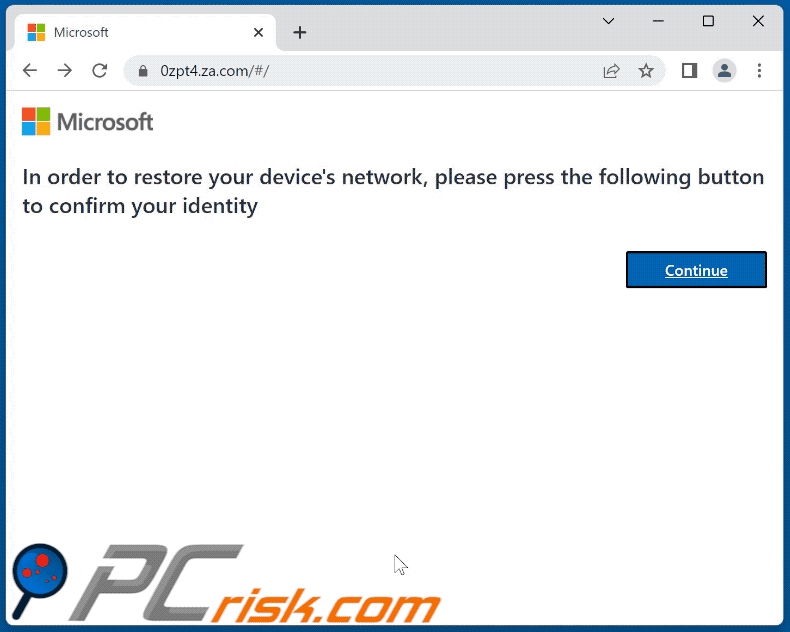
Screenshot of the "Appearance of Abnormal Network Traffic On This Device" pop-up scam's process [Windows host process (Rundll32)] in Windows Task Manager:
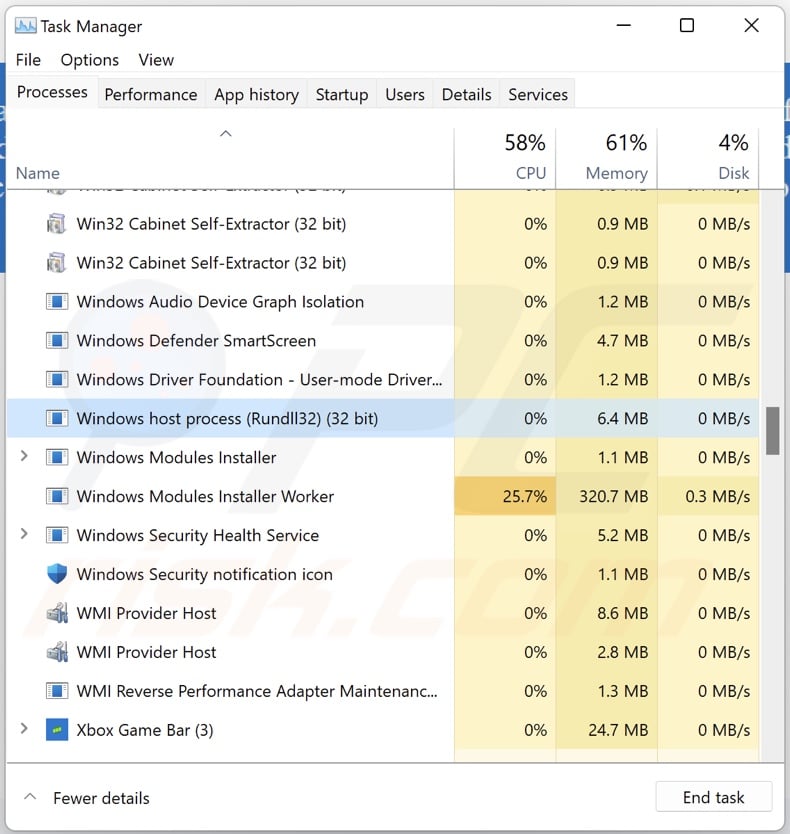
Screenshot of a deceptive website promoting the malicious installer:
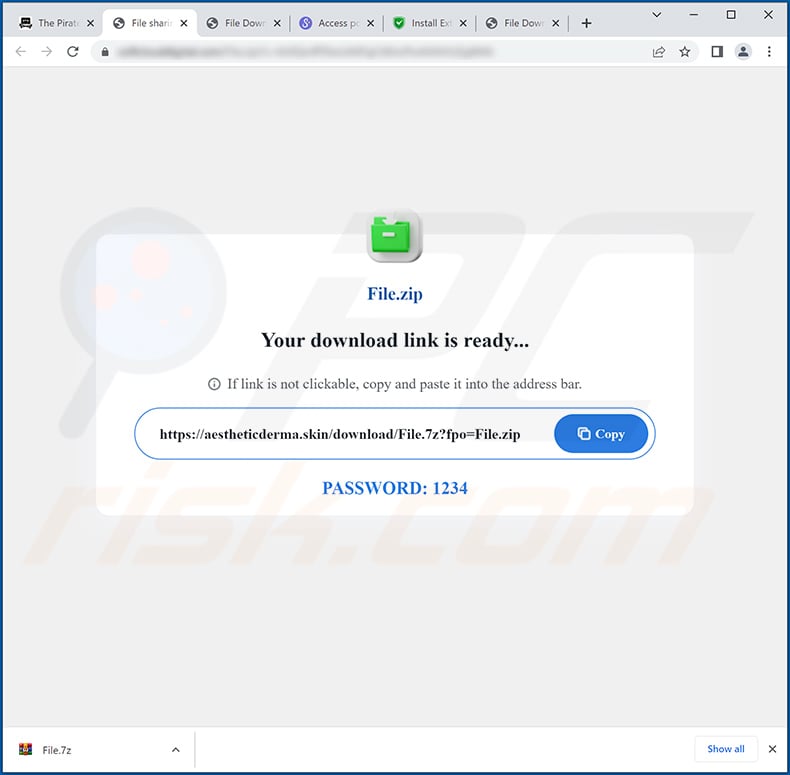
In order to restore the Internet connection users have to perform the following steps:
- Go to Settings
- Click "Network & internet"
- Select "Advanced network settings"
- Disable and re-enable the Ethernet device
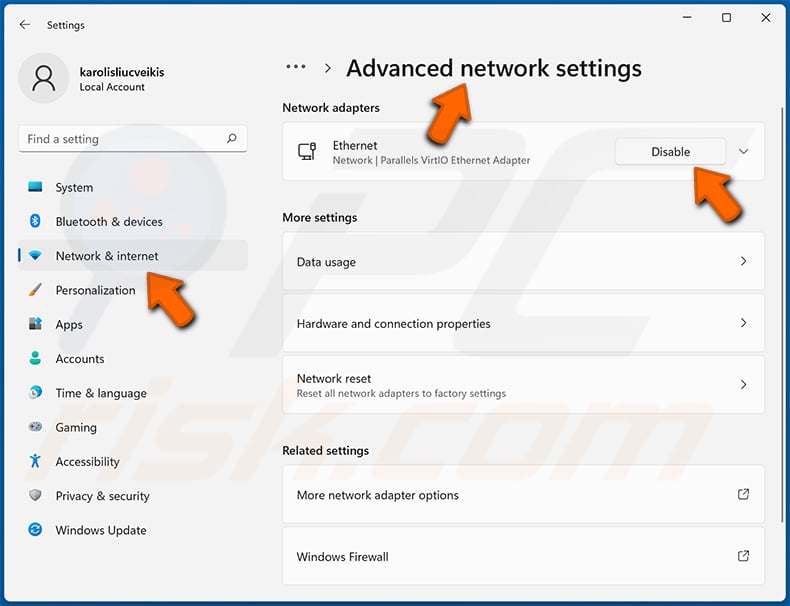
Video showing how to remove "Abnormal Network Traffic On This Device" pop-up scam using Combo Cleaner:
Instant automatic malware removal:
Manual threat removal might be a lengthy and complicated process that requires advanced IT skills. Combo Cleaner is a professional automatic malware removal tool that is recommended to get rid of malware. Download it by clicking the button below:
DOWNLOAD Combo CleanerBy downloading any software listed on this website you agree to our Privacy Policy and Terms of Use. To use full-featured product, you have to purchase a license for Combo Cleaner. 7 days free trial available. Combo Cleaner is owned and operated by RCS LT, the parent company of PCRisk.com.
Quick menu:
- What is "Abnormal Network Traffic On This Device" pop-up?
- How to identify a pop-up scam?
- How do pop-up scams work?
- How to remove fake pop-ups?
- How to prevent fake pop-ups?
- What to do if you fell for a pop-up scam?
How to identify a pop-up scam?
Pop-up windows with various fake messages are a common type of lures cybercriminals use. They collect sensitive personal data, trick Internet users into calling fake tech support numbers, subscribe to useless online services, invest in shady cryptocurrency schemes, etc.
While in the majority of cases these pop-ups don't infect users' devices with malware, they can cause direct monetary loss or could result in identity theft.
Cybercriminals strive to create their rogue pop-up windows to look trustworthy, however, scams typically have the following characteristics:
- Spelling mistakes and non-professional images - Closely inspect the information displayed in a pop-up. Spelling mistakes and unprofessional images could be a sign of a scam.
- Sense of urgency - Countdown timer with a couple of minutes on it, asking you to enter your personal information or subscribe to some online service.
- Statements that you won something - If you haven't participated in a lottery, online competition, etc., and you see a pop-up window stating that you won.
- Computer or mobile device scan - A pop-up window that scans your device and informs of detected issues - is undoubtedly a scam; webpages cannot perform such actions.
- Exclusivity - Pop-up windows stating that only you are given secret access to a financial scheme that can quickly make you rich.
Example of a pop-up scam:

How do pop-up scams work?
Cybercriminals and deceptive marketers usually use various advertising networks, search engine poisoning techniques, and shady websites to generate traffic to their pop-ups. Users land on their online lures after clicking on fake download buttons, using a torrent website, or simply clicking on an Internet search engine result.
Based on users' location and device information, they are presented with a scam pop-up. Lures presented in such pop-ups range from get-rich-quick schemes to fake virus scans.
How to remove fake pop-ups?
In most cases, pop-up scams do not infect users' devices with malware. If you encountered a scam pop-up, simply closing it should be enough. In some cases scam, pop-ups may be hard to close; in such cases - close your Internet browser and restart it.
In extremely rare cases, you might need to reset your Internet browser. For this, use our instructions explaining how to reset Internet browser settings.
How to prevent fake pop-ups?
To prevent seeing pop-up scams, you should visit only reputable websites. Torrent, Crack, free online movie streaming, YouTube video download, and other websites of similar reputation commonly redirect Internet users to pop-up scams.
To minimize the risk of encountering pop-up scams, you should keep your Internet browsers up-to-date and use reputable anti-malware application. For this purpose, we recommend Combo Cleaner Antivirus for Windows.
What to do if you fell for a pop-up scam?
This depends on the type of scam that you fell for. Most commonly, pop-up scams try to trick users into sending money, giving away personal information, or giving access to one's device.
- If you sent money to scammers: You should contact your financial institution and explain that you were scammed. If informed promptly, there's a chance to get your money back.
- If you gave away your personal information: You should change your passwords and enable two-factor authentication in all online services that you use. Visit Federal Trade Commission to report identity theft and get personalized recovery steps.
- If you let scammers connect to your device: You should scan your computer with reputable anti-malware (we recommend Combo Cleaner Antivirus for Windows) - cyber criminals could have planted trojans, keyloggers, and other malware, don't use your computer until removing possible threats.
- Help other Internet users: report Internet scams to Federal Trade Commission.
Frequently Asked Questions (FAQ)
What is a pop-up scam?
Basically, pop-up scams are deceptive messages intended to trick users into performing specific actions. For example, victims can be enticed/scared into providing private data, making monetary transactions, calling fake support lines, allowing cyber criminals to remotely access devices, downloading/installing software, purchasing products, subscribing to services, etc.
What is the purpose of a pop-up scam?
Pop-up scams are designed to generate revenue for cyber criminals. Scammers primarily profit by obtaining funds through deception, abusing or selling sensitive information, promoting content, and proliferating malware.
I have provided my personal information when tricked by a scam, what should I do?
If you have disclosed your personal-identifiable or finance-related information (e.g., ID card details, passport scans/photos, credit card numbers, etc.) – immediately contact the corresponding authorities. And if you've provided your account credentials – change the password of all potentially exposed accounts and inform their official support without delay.
Why do I encounter fake pop-ups?
The "Abnormal Network Traffic On This Device" scam has been observed being promoted through a malicious setup. However, scams are endorsed using various techniques. Deceptive websites are most commonly accessed via redirects caused by pages that use rogue advertising networks, misspelled URLs, spam browser notifications, intrusive ads, or installed adware.
Will Combo Cleaner protect me from pop-up scams?
Combo Cleaner is designed to detect and eliminate threats. It can scan devices and remove unwanted/malicious content (i.e., adware, browser hijackers, malware, etc.). Additionally, Combo Cleaner is capable of scanning visited websites and issuing alerts if they are found to be suspicious/malicious. Hence, should you enter such a page – you will be warned immediately, and further access to it will be blocked.
Share:

Tomas Meskauskas
Expert security researcher, professional malware analyst
I am passionate about computer security and technology. I have an experience of over 10 years working in various companies related to computer technical issue solving and Internet security. I have been working as an author and editor for pcrisk.com since 2010. Follow me on Twitter and LinkedIn to stay informed about the latest online security threats.
PCrisk security portal is brought by a company RCS LT.
Joined forces of security researchers help educate computer users about the latest online security threats. More information about the company RCS LT.
Our malware removal guides are free. However, if you want to support us you can send us a donation.
DonatePCrisk security portal is brought by a company RCS LT.
Joined forces of security researchers help educate computer users about the latest online security threats. More information about the company RCS LT.
Our malware removal guides are free. However, if you want to support us you can send us a donation.
Donate
▼ Show Discussion